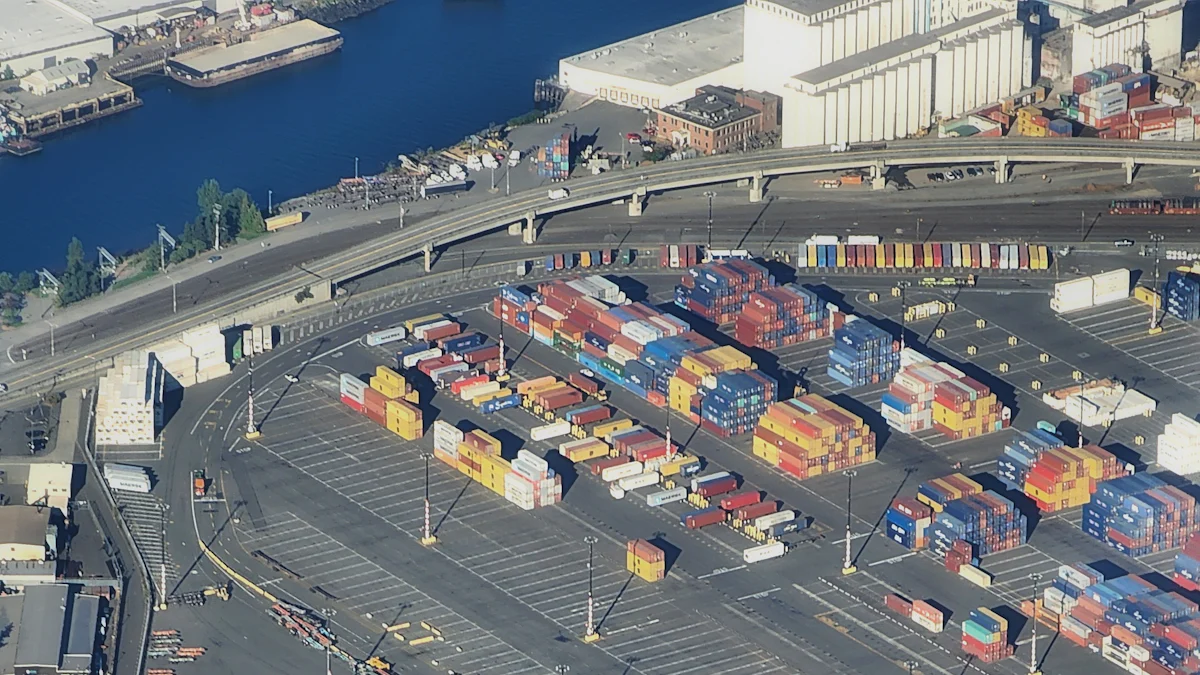Innovative Solutions Driving Cross-Border E-commerce Logistics

The rapid growth of cross-border e-commerce has reshaped global trade, creating an urgent need for innovative logistics solutions. With the global e-commerce market projected to reach $27.9 trillion by the end of 2023, efficient logistics systems have become essential. Consumers now demand faster deliveries, sustainable practices, and seamless international transactions. Advanced technologies like artificial intelligence and blockchain are revolutionizing cross-border e-commerce logistics, ensuring transparency and operational efficiency. These innovations not only address complex challenges but also set the foundation for a more connected and customer-focused global trade ecosystem.
Key Takeaways
Stay informed about regulatory changes to avoid delays and penalties in cross-border shipping.
Adopt sustainable practices like eco-friendly packaging and green transportation to meet consumer demands and enhance your brand's reputation.
Leverage advanced technologies such as AI and machine learning to optimize logistics operations and improve inventory management.
Implement automation and robotics in warehouses to increase efficiency and reduce human error in order fulfillment.
Provide real-time tracking and transparent communication to enhance customer satisfaction and build trust.
Explore innovative shipping solutions like JUSDA’s China-Europe Express Rail to balance speed, cost, and sustainability.
Personalize shipping options to cater to evolving consumer expectations for flexibility and convenience.
Current Trends and Challenges in Cross-Border E-commerce Logistics
The landscape of cross-border e-commerce logistics continues to evolve, driven by dynamic trends and persistent challenges. As businesses expand into international e-commerce, understanding these factors becomes essential for success.
Regulatory and Compliance Issues
Navigating regulatory frameworks remains a significant hurdle in cross-border shipping. Each country enforces unique customs regulations, tax policies, and trade restrictions. You must stay updated on these rules to avoid delays or penalties. For instance, the European Union’s VAT reforms have added complexity for businesses shipping goods into the region.
Adapting to these changes requires robust systems for compliance management. Automated tools can help you streamline documentation and ensure adherence to international standards. By investing in these solutions, you reduce risks and maintain smooth operations.
Sustainability Pressures in Cross-Border Shipping
Sustainability has become a priority in cross-border e-commerce logistics. Consumers now demand eco-friendly practices, pushing companies to adopt greener solutions. Traditional shipping methods often contribute to carbon emissions, making it crucial for you to explore alternatives.
Innovative approaches like green transportation and eco-friendly packaging are gaining traction. Rail transport, such as JUSDA’s China-Europe Express Rail, offers a sustainable option by reducing reliance on air freight. These initiatives not only align with consumer expectations but also enhance your brand’s reputation in the international e-commerce market.
Evolving Consumer Expectations in Cross-Border E-commerce
Modern consumers expect speed, transparency, and flexibility in cross-border e-commerce. They want faster deliveries, real-time tracking, and personalized shipping options. Meeting these demands requires you to embrace emerging technologies and optimize your supply chain.
Automation plays a pivotal role here. Smart warehouses and robotic systems improve efficiency in inventory management and order fulfillment. Additionally, AI-driven platforms enhance customer experience by providing accurate delivery estimates and tailored solutions. Staying ahead of these emerging trends ensures you remain competitive in the ever-changing market trends of international e-commerce.
Technological Advancements Transforming Cross-Border E-commerce Logistics

The integration of advanced technologies is reshaping how you manage cross-border e-commerce logistics. These innovations not only streamline operations but also enhance efficiency and customer satisfaction. By adopting cutting-edge tools, you can stay competitive in the fast-evolving global market.
Artificial Intelligence (AI) and Machine Learning in Logistics
Artificial intelligence (AI) and machine learning are revolutionizing cross-border e-commerce. AI optimizes routes, predicts demand, and improves inventory management. For example, AI-driven platforms analyze vast amounts of data to identify the most efficient shipping routes. This reduces delivery times and minimizes costs. Machine learning algorithms also help you forecast demand fluctuations, ensuring that your inventory aligns with customer needs.
AI enhances collaboration across supply chains. It enables real-time communication between suppliers, carriers, and customers. This transparency fosters trust and ensures smooth operations. Additionally, AI-powered tools improve last-mile delivery by reducing costs and increasing the number of goods delivered per vehicle. By leveraging these technologies, you can achieve greater operational efficiency and meet consumer expectations.
Blockchain Technology for Cross-Border Shipping
Blockchain technology is transforming cross-border e-commerce logistics by enhancing security and transparency. It creates a decentralized ledger that records every transaction in the supply chain. This ensures data accuracy and prevents tampering. For instance, blockchain allows you to trace a product's journey from origin to destination. This level of traceability builds trust with your customers.
Blockchain also simplifies customs clearance. It provides authorities with real-time access to shipping documents, reducing delays and errors. Smart contracts, a feature of blockchain, automate payment processes. They release funds only when predefined conditions are met, ensuring fairness for all parties involved. By adopting blockchain, you can streamline operations and enhance the reliability of your logistics network.
Automation and Robotics in Cross-Border E-commerce Logistics
Automation and robotics are key drivers of efficiency in cross-border e-commerce. Automated warehouses use advanced robotics to handle tasks like picking, packing, and sorting. These systems reduce human error and speed up order fulfillment. For example, robotic arms and conveyor systems work together to process orders quickly and accurately.
Smart warehouses equipped with IoT devices provide real-time inventory updates. This helps you track stock levels and avoid shortages. Automation also extends to transportation. Autonomous vehicles and drones are emerging as viable options for last-mile delivery. These innovations reduce costs and improve delivery times, giving you a competitive edge in the market.
By embracing automation, you can scale your operations without compromising quality. These technologies enable you to meet the growing demands of cross-border e-commerce while maintaining high standards of service.
Sustainability Initiatives in Cross-Border E-commerce Logistics

Sustainability has become a cornerstone of modern cross-border e-commerce logistics. As a business, adopting sustainable shipping practices not only meets consumer expectations but also aligns with global environmental goals. By integrating eco-friendly solutions into your logistics operations, you can reduce your carbon footprint and enhance your brand's reputation.
Eco-Friendly Packaging and Green Transportation
Eco-friendly packaging plays a vital role in reducing waste in cross-border shipping. By using biodegradable or recyclable materials, you minimize the environmental impact of your shipments. For instance, replacing traditional plastic fillers with paper-based alternatives can significantly cut down on non-biodegradable waste. You also save costs in the long run by reducing packaging material usage.
Green transportation solutions further enhance sustainability in logistics. Rail transport, electric vehicles, and hybrid trucks offer alternatives to traditional fuel-based methods. These options lower carbon emissions and improve operational efficiency. For example, electric delivery vans are increasingly used for last-mile deliveries, providing a cleaner and quieter alternative to conventional vehicles. By adopting green transportation, you not only comply with regulatory requirements but also contribute to a healthier planet.
"Green transportation solutions in cross-border e-commerce logistics reduce carbon emissions and operational costs, aligning with sustainability goals and enhancing environmental performance."
Implementing these practices demonstrates your commitment to sustainable shipping practices. This approach not only benefits the environment but also strengthens customer loyalty by showing that your business values eco-conscious operations.
The Role of JUSDA’s China-Europe Express Rail in Sustainable Cross-Border Shipping
JUSDA’s China-Europe Express Rail exemplifies how rail transport can revolutionize sustainable shipping practices. This service offers a balanced solution between speed and cost while significantly reducing carbon emissions compared to air freight. With a transit time of 15-20 days, it provides an efficient alternative to sea freight, which often takes much longer.
The rail service supports a wide range of goods, including electronics, clothing, and medical supplies. By leveraging this mode of transportation, you can align your logistics operations with sustainability goals. The China-Europe Express Rail also minimizes the risk of delays through seamless customs operations and resource alignment. This ensures that your shipments reach their destination efficiently and sustainably.
Additionally, the service integrates sea-rail intermodal solutions, connecting markets in Japan, South Korea, and Taiwan to Europe. This expansion enhances connectivity while maintaining a focus on eco-friendly practices. By utilizing JUSDA’s rail service, you can optimize your supply chain while contributing to global sustainability efforts.
Incorporating such innovative solutions into your logistics strategy allows you to stay ahead in the competitive cross-border e-commerce market. Sustainable shipping practices like these not only reduce environmental impact but also position your business as a leader in responsible logistics.
Enhancing Customer Experience in Cross-Border E-commerce
Faster and Reliable Delivery Options
Consumers value speed and reliability when shopping across borders. Meeting these expectations requires you to prioritize efficient logistics systems. Faster delivery times not only enhance customer satisfaction but also build trust in your services. Studies show that delays in shipping often lead to cart abandonment, making timely deliveries a critical factor in retaining customers.
To achieve this, you can adopt advanced technologies like route optimization tools. These tools analyze traffic patterns and weather conditions to determine the quickest delivery routes. Additionally, integrating automated sorting systems in warehouses reduces processing time, ensuring that orders are dispatched promptly. By focusing on speed and reliability, you create a seamless shopping experience for your customers.
Personalized and Flexible Shipping Solutions
Modern consumers demand flexibility in their shipping options. They want the ability to choose delivery times, locations, and methods that suit their needs. Offering personalized shipping solutions helps you cater to these preferences, enhancing the overall shopping experience.
You can implement features like multiple delivery options, including standard, express, and same-day shipping. Allowing customers to select specific delivery windows or pickup points adds convenience. For instance, locker delivery services provide a secure and flexible option for those unable to receive packages at home. By tailoring your shipping services, you demonstrate a commitment to meeting individual customer needs.
Transparent Communication and Real-Time Tracking
Transparency plays a vital role in cross-border e-commerce. Customers expect to know the status of their orders at every stage of the shipping process. Real-time tracking provides this visibility, allowing them to monitor their packages from dispatch to delivery.
You can integrate tracking systems that update customers on their shipment's location and estimated arrival time. Notifications via email or SMS keep them informed, reducing anxiety about delays or lost packages. Real-time tracking also benefits your operations by enabling proactive issue resolution. For example, if a shipment faces unexpected delays, you can notify the customer immediately and offer alternative solutions. This level of transparency builds trust and strengthens customer loyalty.
"Real-time tracking enhances customer satisfaction by providing visibility and reducing uncertainty in cross-border e-commerce logistics."
By prioritizing transparent communication, you foster a positive relationship with your customers. They feel valued and informed, which encourages repeat business and positive reviews.
Innovative solutions are reshaping cross-border e-commerce logistics, enabling you to overcome challenges and seize new opportunities. Technology plays a pivotal role in this transformation. Tools like artificial intelligence, IoT, and data analytics optimize operations and improve customer experiences. Sustainability initiatives, such as eco-friendly packaging and green transportation, address environmental concerns while enhancing your brand's value. JUSDA’s China-Europe Express Rail exemplifies how forward-thinking logistics solutions can balance efficiency and sustainability. By embracing these advancements, you position your business to thrive in the evolving global trade landscape.
See Also
Exploring Supplier Partnerships in Global E-commerce Innovations
Transforming Logistics Through Innovative Supply Chain Strategies
Future Logistics Transformed by AI in Supply Chains
Addressing Global Supply Chain Growth Challenges Effectively
Enhancing Global E-commerce Through Supply Chain Transparency
